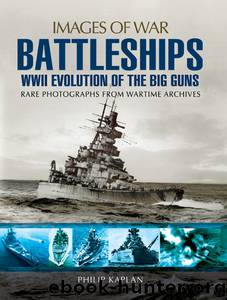Battleships: WWII Evolution of the Big Guns - Rare Photographs from Wartime Archives by Philip Kaplan

Author:Philip Kaplan
Language: eng
Format: epub
Tags: HISTORY / Military / Naval
ISBN: 9781473843578
Publisher: Pen and Sword
Published: 2015-06-15T04:00:00+00:00
A sixteen-inch shell from the warship.
The commemorative surrender plaque in the deck of the Missouri.
General Douglas MacArthur signing the surrender documents on 2 September 1945.
An RPV drone on Missouri.
The breech of a sixteen-inch gun of the Japanese battleship Nagato.
MacArthur used five different pens when he signed the surrender document. The pens were later presented to U.S. Army Lieutenant General Jonathan Wainwright, Theatre Commander at Corregidor and a survivor of the Bataan Death March, British Army Lieutenant-General Arthur Percival, Commander of Malaya, the United States National Archives, the U.S. Military Academy, West Point, and Mrs Douglas MacArthur. The signing was to take place at a fine old mahogany table provided by the crew of the British battleship HMS King George V. However, the table was too small for the surrender documents, so an ordinary table from the enlisted men’s mess of Missouri was substituted. It was covered with a green felt cloth from the officers’ mess. It is now part of the collections of the Navy Museum at the U.S. Naval Academy, Annapolis, Maryland.
Tony Alessandro: “On 15 August 1945, news broke that the war was over. Everyone was blowing whistles and there was a lot of dancing and hugging going on—but the celebration eventually subsided. It was business as usual for the crew. Many of us were still apprehensive, and for good reason; five Japanese pilots had attacked the fleet that morning. All five were shot down by navy gunners. By 28 August the Missouri was headed for Tokyo Bay. A lot of my buddies and I were pretty scared. We didn’t know if it was a trap or if Japan really meant to surrender. I was on a working party with two other shipmates. We brought Japanese harbour pilots aboard from another ship while we were under way, before entering Tokyo Bay. They told us about the mine fields and harbour defences and on the morning of 29 August we passed into Tokyo Bay at Condition Two, a state of medium alert, and dropped anchor without incident.
Download
This site does not store any files on its server. We only index and link to content provided by other sites. Please contact the content providers to delete copyright contents if any and email us, we'll remove relevant links or contents immediately.
| Africa | Americas |
| Arctic & Antarctica | Asia |
| Australia & Oceania | Europe |
| Middle East | Russia |
| United States | World |
| Ancient Civilizations | Military |
| Historical Study & Educational Resources |
The Radium Girls by Kate Moore(11633)
100 Deadly Skills by Clint Emerson(4697)
The Templars by Dan Jones(4561)
Rise and Kill First by Ronen Bergman(4549)
The Doomsday Machine by Daniel Ellsberg(4250)
The Rape of Nanking by Iris Chang(4024)
Killing England by Bill O'Reilly(3900)
Hitler in Los Angeles by Steven J. Ross(3803)
Stalin by Stephen Kotkin(3731)
12 Strong by Doug Stanton(3420)
Hitler's Monsters by Eric Kurlander(3168)
Blood and Sand by Alex Von Tunzelmann(3060)
Darkest Hour by Anthony McCarten(3019)
The Code Book by Simon Singh(2866)
The Art of War Visualized by Jessica Hagy(2845)
Hitler's Flying Saucers: A Guide to German Flying Discs of the Second World War by Stevens Henry(2625)
Babylon's Ark by Lawrence Anthony(2435)
The Second World Wars by Victor Davis Hanson(2423)
Tobruk by Peter Fitzsimons(2380)
